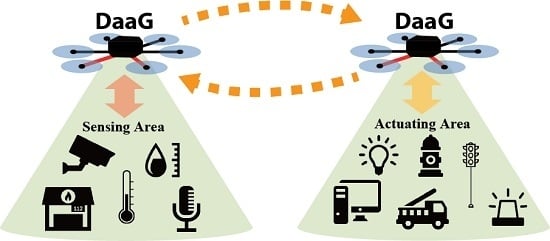Devising Mobile Sensing and Actuation Infrastructure with Drones
Abstract
:1. Introduction
2. Designing DaaG
2.1. Design Consideration
- Connectivity: This enables the sensor network and actuator network to share their data when they are physically separated. Additionally, it acts as a data ferry, to deliver the data between the sensor and the actuator network, or a routing node in a multi-hop network, represented as Figure 1a, to forward the data between them. The most distinctive feature of the two methods is the mobility of the drones during the network provisioning service. In the data ferry method, represented as Figure 1b, the drones continuously travel between the sensors and the actuators. In the multi-hop network method, the drones hover and relay data between the sensors and the actuators.
- Automated system: It can self-determine its flight plan to efficiently collect sensor data and appropriately decide the actuation.
- Smartness: It should be smart enough to translate sensor data and actuation control between the sensor and actuator network since the latter cannot directly interpret raw sensor data that the former delivers and vice versa.
2.2. Structure of DaaG
2.2.1. Task Management Module
2.2.2. Drone Flight Control Modules
2.2.3. Communication Modules
2.3. Main Functions of DaaG
| Algorithm 1 Backoff-based beaconing algorithm. |
|
2.3.1. Communication Scheduling
2.3.2. Smart Data Processing
- the difference between and is larger than threshold value ,
- is lower than predefined lower bound ,
- is higher than predefined upper bound ,
2.3.3. Path Planning
| Algorithm 2 Path-planning algorithm in the sensor network. |
|
| Algorithm 3 Path-planning algorithm in the actuator network. |
|
2.3.4. Data Transfer Method Selection
3. Simulations
3.1. Network Performance
3.1.1. Simulation Setup
- The number of sensors in the sensing area is 30.
- The number of actuators in the actuating area is 10.
- The number of drone is one.
- The distance between the sensing area and actuating area is 160 m.
- Drones going to the actuator pass the sensing area.
- The problematic sensor is the southern-most node in the sensing area.
- All sensors, actuators and drones are equipped with a Wi-Fi interface for communication.
- The maximum throughput of sensors is limited to 100 Kbps
3.1.2. Simulation Results in the Data Ferry Method
3.1.3. Simulation Results in the DaaG Multi-Hop Network Method
3.1.4. Network Throughput Comparison between the Data Ferry and Multi-Hop Method
3.2. Energy Consumption
3.2.1. Simulation Setup in the Energy Consumption Simulation
3.2.2. Simulation Result
3.3. Main Focusing Delay
3.3.1. Simulation Setup
3.3.2. Simulation Result
4. Implementing and Evaluating DaaG
4.1. Exemplary Scenario
- There are two separated areas, a sensing area and an actuating area, any one of which is not connected to the other.
- Sensors in the sensing area measure the light intensity value.
- Actuators in the actuating area are filming the sensors, but the number of actuators is smaller than the sensors.
- Drone #1 (DaaG) flies over the sensing area, associates itself with sensors in the sensing area and retrieves the sensed data from the sensors.
- Drone #1 visits the actuating area and calculates the angle of the actuators.
- Drone #1 sends the angle data to the actuators to film the sensor that detects an event.
4.2. Implementation
4.2.1. DaaG Hardware
4.2.2. DaaG Software
| Algorithm 4 DaaG IoT control decision algorithm. |
|
4.2.3. Prototypes for Sensors and Actuators
4.2.4. Drone Control System
4.3. Empirical Deployment
4.4. Empirical Evaluation
4.4.1. Observing Empirical Results
- First, based on the starting position of Drone #1 and the location of the sensing and actuating area, the expected path of Drone #1 is in Figure 10a for both the DaaG and nearest-based planned path drone.
- Since the light intensity value of Sensor #1 is lower than the threshold in our scenario, Drone #1 runs Algorithm 3, then Sensor #1 is registered in PSL, and will be the highest.
- After that, Drone #1 changes the path to visit Actuator #1 rather than Actuator #2, and Figure 10b shows the changed path after running Algorithm 3.
- When Drone #1 has arrived at Actuator #1, it sends an actuation message, which rotates the servo motor to focus on Sensor #1, to Actuator #1, as Figure 10c shows.
4.4.2. Examining Observations
5. Conclusions
Acknowledgments
Author Contributions
Conflicts of Interest
Abbreviations
| WSAN | Wireless sensor and actuator network |
| DaaG | Drone-as-a-gateway |
| IoT | Internet of Things |
| M2M | Machine-to-machine |
| DoF | Degree of freedom |
| UAV | Unmanned aerial vehicle |
| GPS | Global Positioning System |
| PSL | Problematic sensor list |
| ACL | Actuator correlation value list |
| TSPN | Traveling salesman problem with neighborhoods |
| CETSP | Close enough traveling salesman problem |
| NCPST | Normalized cumulative priority service throughput |
| OLSR | Optimized link state routing |
| CDF | Cumulative distribution function |
| GCS | Ground control station |
References
- Verdone, R.; Dardari, D.; Mazzini, G.; Conti, A. Wireless Sensor and Actuator Networks: Technologies, Analysis and Design; Academic Press: Cambridge, MA, USA, 2008. [Google Scholar]
- Ericsson AB. Ericsson Mobility Report, November 2017. Available online: http://www.ericsson.com/assets/local/mobility-report/documents/2017/ericsson-mobility-report-november-2017.pdf (accessed on 15 February 2018).
- Deloitte. Cyber-Physical Systems-Government 2020; Deloitte Development LLC: Oakland, CA, USA, 2014. [Google Scholar]
- Lee, W.; Kim, J.; Kang, J. Automated construction of node software using attributes in a ubiquitous sensor network environment. Sensors 2010, 10, 8663–8682. [Google Scholar] [CrossRef] [PubMed]
- Wu, F.J.; Tseng, Y.C. Energy-conserving data gathering by mobile mules in a spatially separated wireless sensor network. Wirel. Commun. Mob. Comput. 2013, 13, 1369–1385. [Google Scholar] [CrossRef]
- Ngai, E.C.; Lyu, M.R.; Liu, J. A real-time communication framework for wireless sensor-actuator networks. In Proceedings of the 2006 IEEE Aerospace Conference, Big Sky, MT, USA, 4–11 March 2006; IEEE: Piscataway, NJ, USA; p. 9. [Google Scholar]
- Meyer, F.; Wymeersch, H.; Fröhle, M.; Hlawatsch, F. Distributed Estimation With Information-Seeking Control in Agent Networks. IEEE J. Sel. Areas Commun. 2015, 33, 2439–2456. [Google Scholar] [CrossRef]
- Ozdemir, S.; Xiao, Y. Secure data aggregation in wireless sensor networks: A comprehensive overview. Comput. Netw. 2009, 53, 2022–2037. [Google Scholar] [CrossRef]
- Lee, S.K.; Bae, M.; Kim, H. Future of IoT Networks: A Survey. Appl. Sci. 2017, 7, 1072. [Google Scholar] [CrossRef]
- Dardari, D.; Conti, A.; Buratti, C.; Verdone, R. Mathematical Evaluation of Environmental Monitoring Estimation Error through Energy-Efficient Wireless Sensor Networks. IEEE Trans. Mob. Comput. 2007, 6, 790–802. [Google Scholar] [CrossRef]
- Ferdoush, S.; Li, X. Wireless Sensor Network System Design Using Raspberry Pi and Arduino for Environmental Monitoring Applications. Procedia Comput. Sci. 2014, 34, 103–110. [Google Scholar] [CrossRef]
- Zabini, F.; Conti, A. Inhomogeneous Poisson Sampling of Finite-Energy Signals With Uncertainties in ℝd. IEEE Trans. Signal Process. 2016, 64, 4679–4694. [Google Scholar] [CrossRef]
- Deaconu, I.; Voinescu, A. Mobile gateway for wireless sensor networks utilizing drones. In Proceedings of the 2014 RoEduNet Conference 13th Edition: Networking in Education and Research Joint Event RENAM 8th Conference, Chisinau, Moldova, 11–13 September 2014; IEEE: Piscataway, NJ, USA; pp. 1–5. [Google Scholar]
- Saleem, Y.; Salim, F.; Rehmani, M.H. Resource management in mobile sink based wireless sensor networks through cloud computing. In Resource Management in Mobile Computing Environments; Springer: Cham, Switzerland, 2014; pp. 439–459. [Google Scholar]
- Tunca, C.; Isik, S.; Donmez, M.Y.; Ersoy, C. Distributed mobile sink routing for wireless sensor networks: A survey. IEEE Commun. Surv. Tutor. 2014, 16, 877–897. [Google Scholar] [CrossRef]
- Trasviña-Moreno, C.A.; Blasco, R.; Marco, Á.; Casas, R.; Trasviña-Castro, A. Unmanned aerial vehicle based wireless sensor network for marine-coastal environment monitoring. Sensors 2017, 17, 460. [Google Scholar] [CrossRef] [PubMed]
- Cao, H.; Liu, Y.; Yue, X.; Zhu, W. Cloud-Assisted UAV Data Collection for Multiple Emerging Events in Distributed WSNs. Sensors 2017, 17, 1818. [Google Scholar] [CrossRef] [PubMed]
- Tzoreff, E.; Weiss, A.J. Path Design for Best Emitter Location Using Two Mobile Sensors. IEEE Trans. Signal Process. 2017, 65, 5249–5261. [Google Scholar] [CrossRef]
- Jung, J.; Kim, K.; Lee, W.; Kim, H. Poster: Asynchronous Acoustic Localization using Commercial Devices. In Proceedings of the 13th ACM Conference on Embedded Networked Sensor Systems, Seoul, Korea, 1–4 November 2015; ACM: New York, NY, USA, 2015; pp. 393–394. [Google Scholar]
- Win, M.Z.; Conti, A.; Mazuelas, S.; Shen, Y.; Gifford, W.M.; Dardari, D.; Chiani, M. Network localization and navigation via cooperation. IEEE Commun. Mag. 2011, 49, 56–62. [Google Scholar] [CrossRef]
- Bartoletti, S.; Dai, W.; Conti, A.; Win, M.Z. A Mathematical Model for Wideband Ranging. IEEE J. Sel. Top. Signal Process. 2015, 9, 216–228. [Google Scholar] [CrossRef]
- Conti, A.; Dardari, D.; Guerra, M.; Mucchi, L.; Win, M.Z. Experimental Characterization of Diversity Navigation. IEEE Syst. J. 2014, 8, 115–124. [Google Scholar] [CrossRef]
- Liu, Z.; Dai, W.; Win, M.Z. Node placement for localization networks. In Proceedings of the 2017 IEEE International Conference on Communications (ICC), Paris, France, 21–25 May 2017; pp. 1–6. [Google Scholar]
- Dumitrescu, A.; Mitchell, J.S.B. Approximation algorithms for TSP with neighborhoods in the plane. CoRR 2017, arXiv:1703.01640. [Google Scholar]
- Gulczynski, D.J.; Heath, J.W.; Price, C.C. The Close Enough Traveling Salesman Problem: A Discussion of Several Heuristics. In Perspectives in Operations Research; Springer: Boston, MA, USA, 2006; Volume 36, pp. 271–283. ISBN 978-0-387-39933-1. [Google Scholar]
- La, W.G.; Park, S.; Kim, H. D-MUNS: Distributed multiple UAVs’ network simulator. In Proceedings of the 2017 Ninth International Conference on Ubiquitous and Future Networks (ICUFN), Milan, Italy, 4–7 July 2017; pp. 15–17. [Google Scholar]
- The ns-3 Network Simulator. Available online: https://www.nsnam.org/ (accessed on 15 February 2018).
- Furrer, F.; Burri, M.; Achtelik, M.; Siegwart, R. Robot Operating System (ROS). In Studies in Computational Intelligence; Springer: Cham, Switzerland, 2016; Chapter 23; Volume 625, pp. 595–625. ISBN 978-3-319-26052-5. [Google Scholar]
- Arya, S.; Mount, D.M.; Netanyahu, N.S.; Silverman, R.; Wu, A.Y. An optimal algorithm for approximate nearest neighbor searching fixed dimensions. JACM 1998, 45, 891–923. [Google Scholar] [CrossRef]
- Salarian, H.; Chin, K.W.; Naghdy, F. An energy-efficient mobile-sink path selection strategy for wireless sensor networks. IEEE Trans. Veh. Technol. 2014, 63, 2407–2419. [Google Scholar] [CrossRef]
- DaaG Simulation Result with Multi-Hop Network Method. Available online: https://youtu.be/cusJZlA4WMc (accessed on 15 February 2018).
- Heinzelman, W.R.; Chandrakasan, A.; Balakrishnan, H. Energy-efficient communication protocol for wireless microsensor networks. In Proceedings of the 33rd Annual Hawaii International Conference on System Sciences, Maui, HI, USA, 4–7 January 2000; IEEE: Piscataway, NJ, USA, 2000; p. 10. [Google Scholar]
- Jafri, M.R.; Javaid, N.; Javaid, A.; Khan, Z.A. Maximizing the lifetime of multi-chain pegasis using sink mobility. arXiv preprint, 2013; arXiv:1303.4347. [Google Scholar]
- Bagci, H.; Yazici, A. An energy aware fuzzy approach to unequal clustering in wireless sensor networks. Appl. Soft Comput. 2013, 13, 1741–1749. [Google Scholar] [CrossRef]
- Chung, A.Y.; Jung, J.; Kim, K.; Lee, H.K.; Lee, J.; Lee, S.K.; Yoo, S.; Kim, H. Poster: Swarming drones can connect you to the network. In Proceedings of the 13th Annual International Conference on Mobile Systems, Applications, and Services, Florence, Italy, 19–22 May 2015; ACM: New York, NY, USA, 2015; p. 477. [Google Scholar]
- Yoo, S.; Jung, J.; Chung, A.Y.; Kim, K.; Lee, J.; Park, S.; Lee, S.K.; Lee, H.K.; Kim, H. Empowering Drones’ Teamwork with Airborne Network. In Proceedings of the 2017 IEEE 31st International Conference on Advanced Information Networking and Applications (AINA), Taipei City, Taiwan, 27–29 March 2017; IEEE: Piscataway, NJ, USA, 2017; pp. 678–685. [Google Scholar]
- Meier, L.; Tanskanen, P.; Heng, L.; Lee, G.H.; Fraundorfer, F.; Pollefeys, M. PIXHAWK: A Micro Aerial Vehicle Design for Autonomous Flight Using Onboard Computer Vision. Auton. Robots 2012, 33, 21–39. [Google Scholar] [CrossRef]
- Meier, L.; Camacho, J.; Godbolt, B.; Goppert, J.; Heng, L.; Lizarraga, M. Mavlink: Micro Air Vehicle Communication Protocol. Available online: http://qgroundcontrol.org/mavlink/start (accessed on 15 February 2018).
- Lee, J.; Kim, K.; Yoo, S.; Chung, A.Y.; Lee, J.Y.; Park, S.J.; Kim, H. Constructing a reliable and fast recoverable network for drones. In Proceedings of the Communications (ICC), 2016 IEEE International Conference on, Kuala Lumpur, Malaysia, 22–27 May 2016; IEEE: Piscataway, NJ, USA, 2016; pp. 1–6. [Google Scholar]
- Devising Mobile Sensing and Actuation Infrastructure with Drones. Available online: https://youtu.be/xxYiXeFMrs (accessed on 15 February 2018).


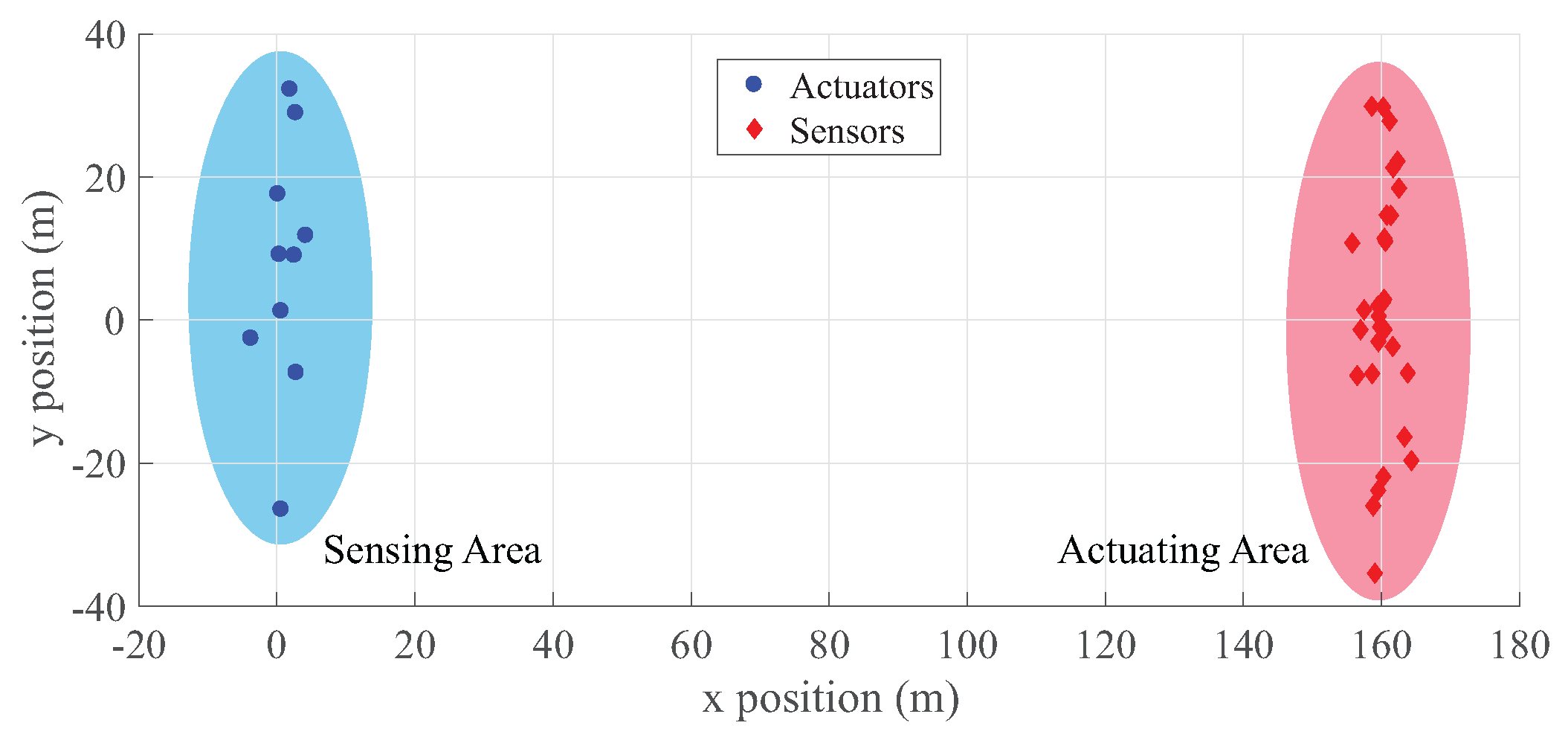




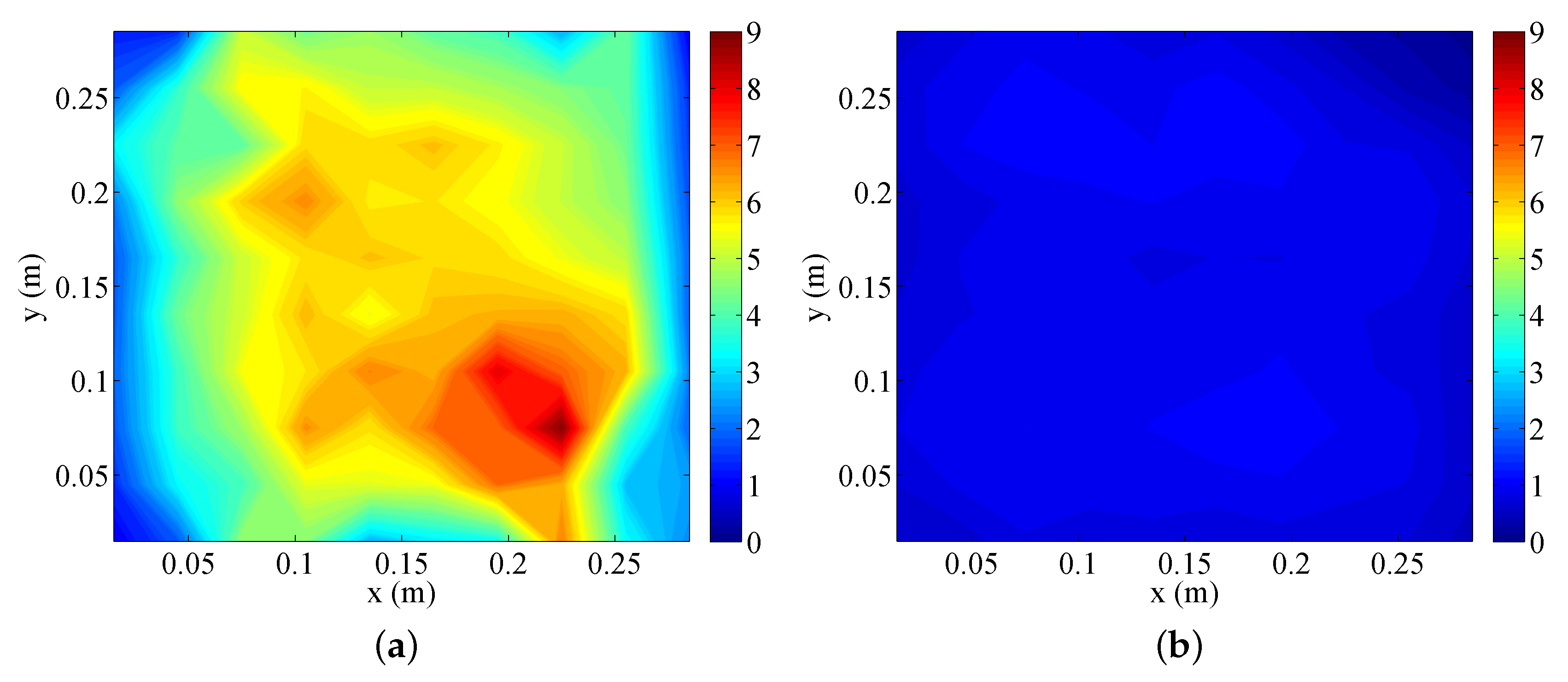
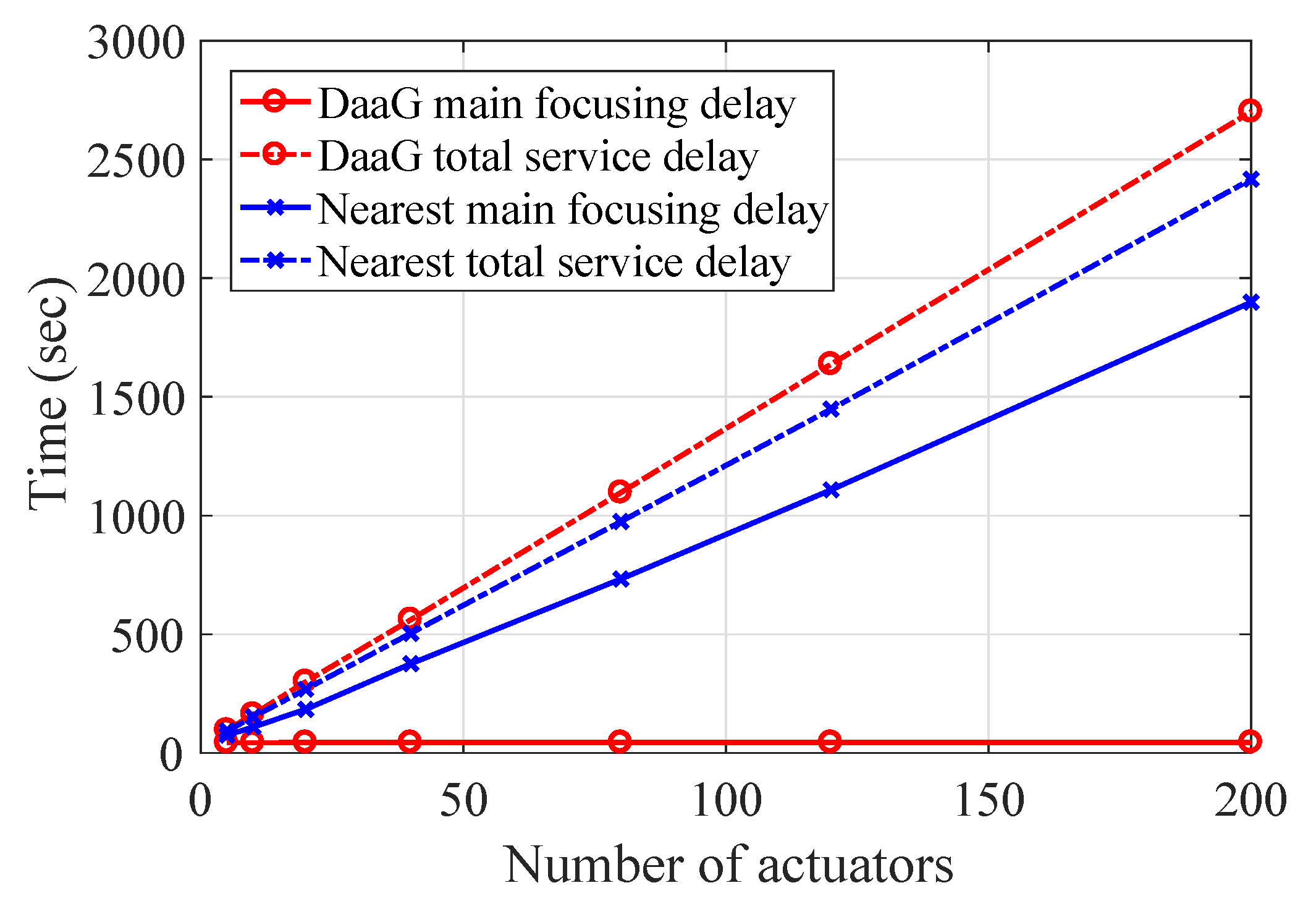
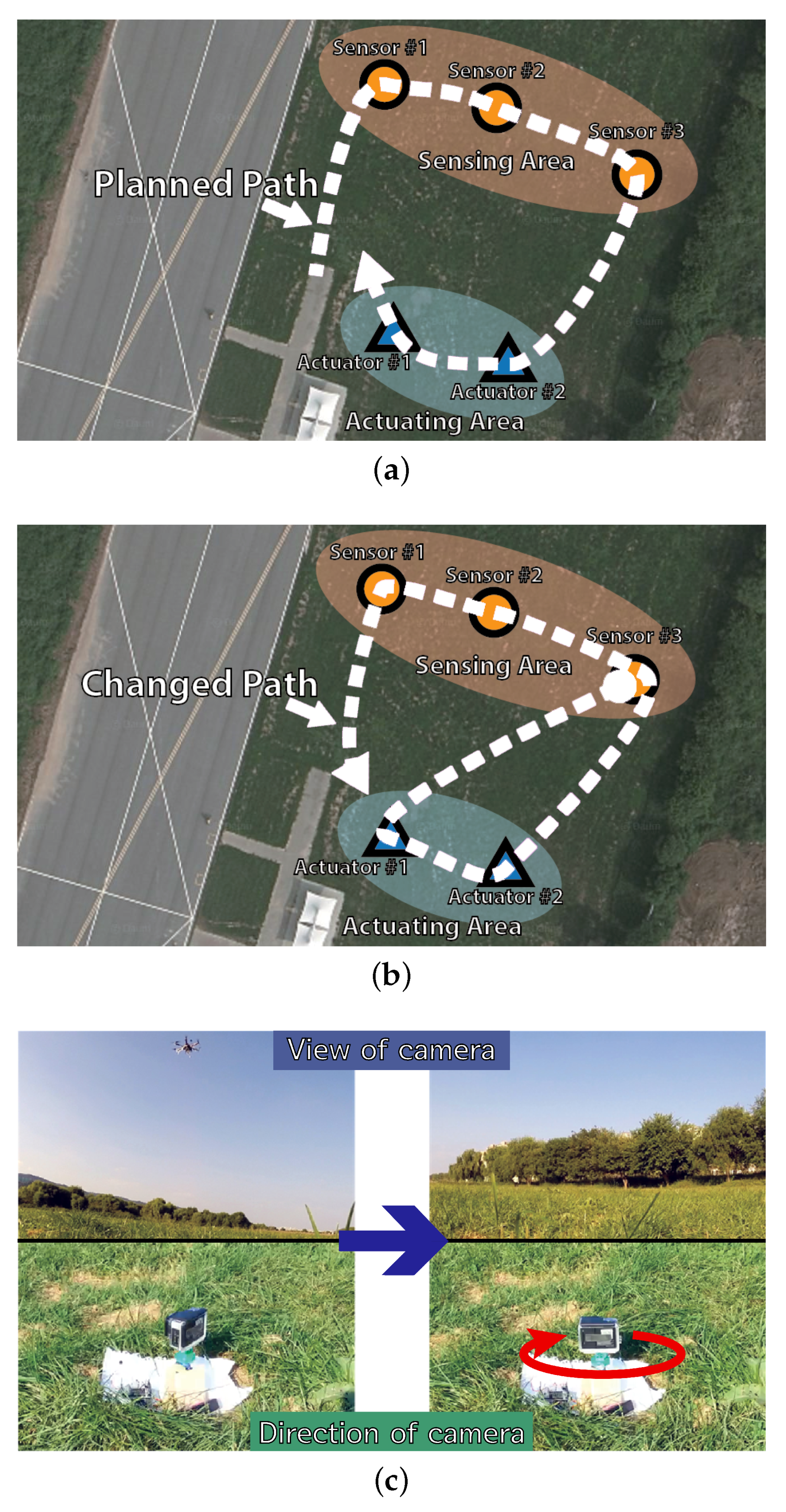

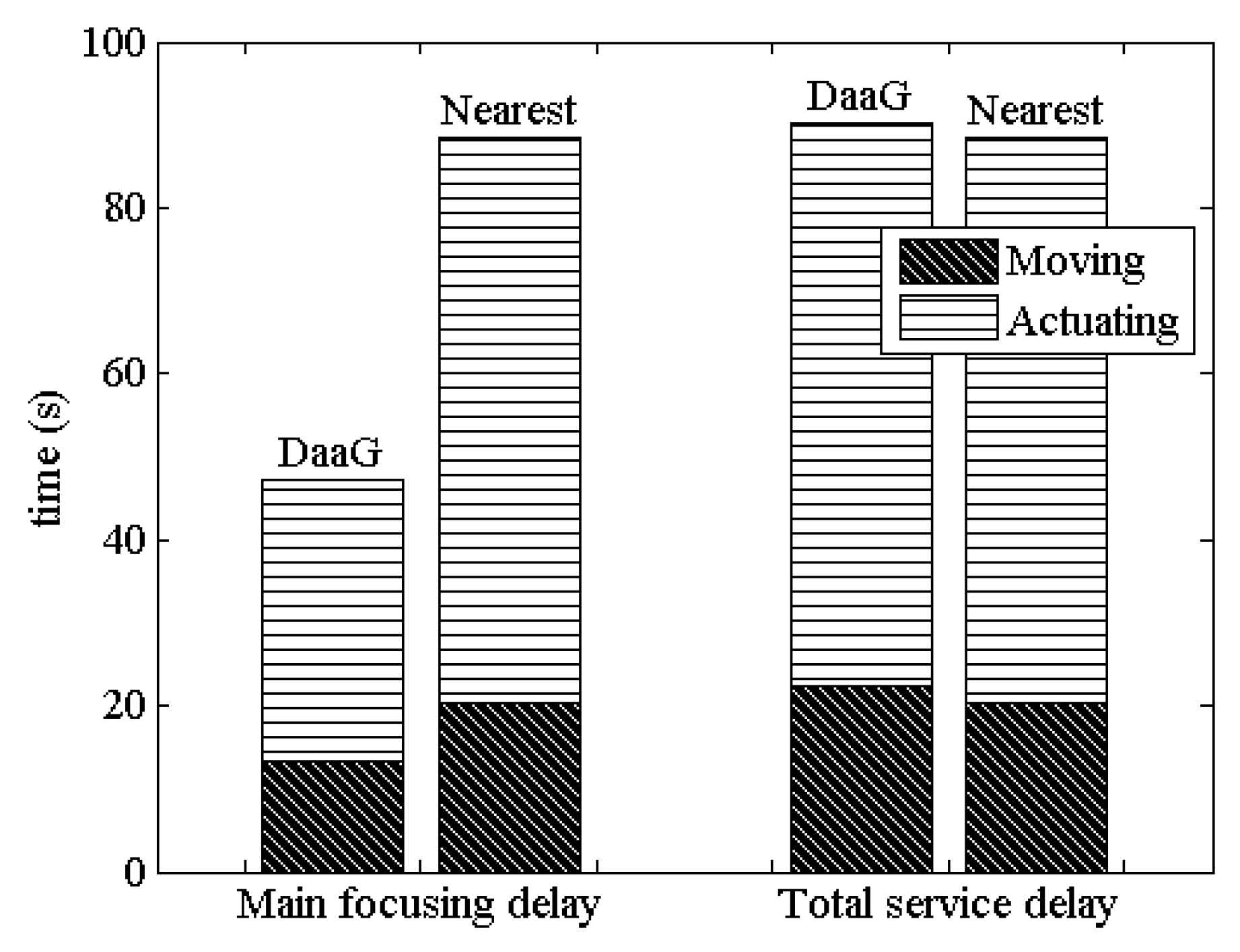
© 2018 by the authors. Licensee MDPI, Basel, Switzerland. This article is an open access article distributed under the terms and conditions of the Creative Commons Attribution (CC BY) license (http://creativecommons.org/licenses/by/4.0/).
Share and Cite
Bae, M.; Yoo, S.; Jung, J.; Park, S.; Kim, K.; Lee, J.Y.; Kim, H. Devising Mobile Sensing and Actuation Infrastructure with Drones. Sensors 2018, 18, 624. https://doi.org/10.3390/s18020624
Bae M, Yoo S, Jung J, Park S, Kim K, Lee JY, Kim H. Devising Mobile Sensing and Actuation Infrastructure with Drones. Sensors. 2018; 18(2):624. https://doi.org/10.3390/s18020624
Chicago/Turabian StyleBae, Mungyu, Seungho Yoo, Jongtack Jung, Seongjoon Park, Kangho Kim, Joon Yeop Lee, and Hwangnam Kim. 2018. "Devising Mobile Sensing and Actuation Infrastructure with Drones" Sensors 18, no. 2: 624. https://doi.org/10.3390/s18020624




